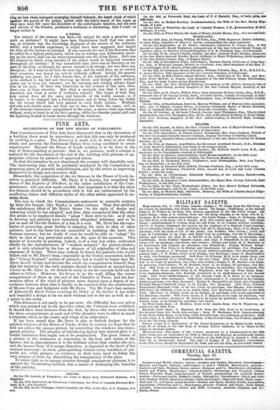FINE ARTS.
DECORATIONS OF THE NEW HOUSES OF PARLIAMENT.
THE Commissioners of Fine Arts have discovered that in the decoration of a building there must be accordance, and that this can only be produced by working to a plan. The discovery is made just in time to save their credit and prevent the Parliament Palace from being sacrificed to crude experiments. Beyond the House of Lords nothing is to be done in the way of fresco-painting at present: that is, we presume, until a scheme is matured for the decoration of the rest of the building with pictures of ap- propriate subjects by painters of approved talent.
So that the intention be not abandoned, the country will cheerfully wait. The intervening time will be profitably employed by the Commission in preparing plans of pictorial embellishment, and by the artists in improving themselves in design and executive skill.
Meanwhile, the completion of the six frescoes in the House of Lords in- volves a practical difficulty. Mr. Dyce, it is known, has completed his fresco of the Baptism of Ethelhert, to the entire satisfaction of the Com- missioners; who are now made sensible how important it is that the other five frescoes should be in accordance with it, but are embarrassed by the conflicting claims and different styles of the other artists appointed to ex- ecute them.
The way in which the Commissioners endeavour to reconcile matters, by their last Report, (the Sixth) is rather curious. They first attribute the satisfactory effect of Mr. Dyce's fresco "to the style of design and colouring which he has adopted," and then they recommend that the other five artists to be employed should " adapt " their style to hie: as if style in drawing and painting were something altogether arbitrary, and to be put on and off like the fashion of a hat or a coat. Mr. Dyes has the repu- tation of possessing great facility in adapting his style to that of other painters, and he has been but too successful in imitating the hard, dry, German manner; but we doubt if even he would be able to " adapt " his style to that of any particular artist on the spur of the moment. This species of dexterity in painting, indeed, is of a very low order, cultivated chiefly by the manufacturers of "modern antiques" for picture-dealers; and is only attained by the loss or absence of all originality of idea and character of design. There may, indeed, be found five painters who would follow suit to Mr. Dyee's lead,-especially as the Gothic mannerism infects the "Young England" section of painters; but it would be better that Mr. Dyce should design and execute the whole six compartments himself, than that his imitation of the early painters should be imitated at second-hand. Clever as Mr. Dyce is, we should be sorry to see his example held out for others to follow. However, his fresco is on the wall, filling the centre compartment of three at one end of the Chamber of Peers; and the har- monious effect of the triad of pictures must depend upon a degree of ac- cordance between them that is hardly to be expected from the combination of Messrs. Cope and Redgrave with Mr. Dyce. Yet Mr. Cope's last cartoon of Edward the Black Prince receiving the Order of the Garter is too noble and beautiful a design to be set aside without loss to the art as well as in- j uatice to the artist.
This dilemma is not easily to be got over; the difficulty has now arisen which was pointed out in the Spectator when the Cartoons were exhibited. It should have been foreseen from the first, by those who were aware that the three compartments at each end of the chamber were in effect as much a tripartite whole as the centre and wings of an altar-piece.
It has been stated that Mr. Dyce is also to furnish designs for the painted windows of the House of Lords; if this be correct, we hope that he will not eclipse his opaque picture by converting the windows into trans- parent pictures. The practice of introducing figures into stained glass is a Gothic barbarism that ought not to be perpetuated. The great charm of a picture is the sentiment or expression in the look and action of the figures; but in glass-pictures it is the brilliant colour that catches the eye, and the human form, if it escape distortion, is degraded to the level of the meanest accessory: in short, glass-painting violates every condition of pie- tonal art; while pictures on windows, in their turn, tend to defeat the very purpose of them, by diminishing the transparency of the glass.
To admit light on to opaque pictures through transparent pictures, is to convert the illuminating medium into a means of destroying the beauties of the painting.


























 Previous page
Previous page